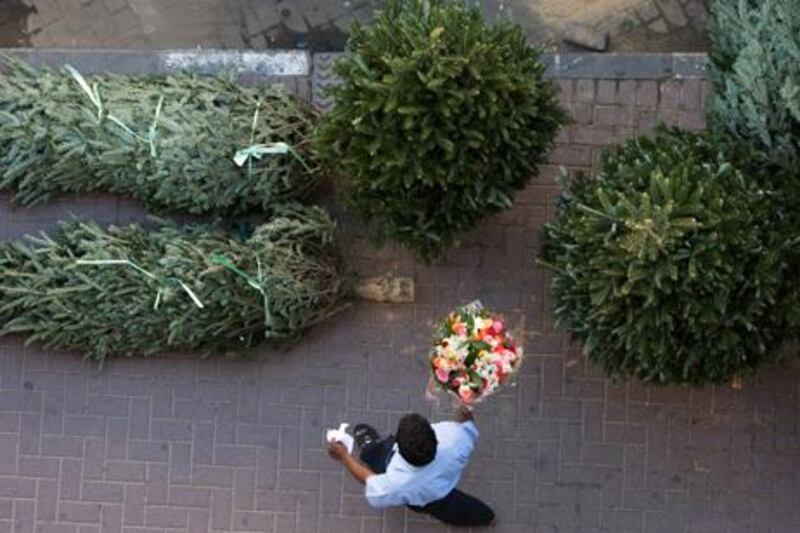It is 5am. Yet again my insomniac baby daughter and I are up before dawn and yet again we're both transfixed by the neon date palms that mark the entrance to our local supermarket. She is captivated by the flashing trunks, dates and fronds that flicker on and off mechanically with hypnotic regularity. Unfortunately, I am merely catatonic and my mind races wildly as I struggle to keep my eyes open. I find myself considering the palm and, although I far prefer the dusty ghaf (Prosopis cineraria) I conclude that the palm is probably a more appropriate symbol, for both the Abu Dhabi Co-operative Society and the UAE as a whole. An oasis of palms is the counterpoint to a drifting landscape of sands, blown by the winds, while the ghaf is unmistakably a tree of the wilderness. Both have their myriad uses but the date palm also speaks of rootedness, cultivation, shelter and plenty - fitting epithets for any nation.
The trees and their lights then bring my thoughts closer to home and I realise that I will have disappointed my wife again by the end of the coming week. This is an annual occurrence as each December she longs for a Christmas tree and each year I say, "Bah humbug!" and refuse. For many years this was particularly cruel as I worked for a nursery that sold hundreds of enormous, high-quality trees. Each night I would return home covered in fragrant, coniferous resin while leaving a trail of needles as I walked to the shower, eager to wash away the cold of a long winter's day, but the fragrance and debris were as close as we ever came to owning our own seasonal tree. When we came to the UAE, I thought that would be an end to the matter but now that our daughter's first Christmas is approaching and the shops are full of trees, lights and decorations, the perennial problem has come back to haunt me. Is it possible to have a Christmas tree that is ethically green?
Much of the festive sustainability debate is focused on whether it is better to buy a real tree every year, or a plastic tree that will last a lifetime. The argument for the plastic tree is undermined somewhat by the fact that plastic trees are used not for a "lifetime", but for an average of five or six times before being discarded to spend the next few centuries degrading in a landfill. Researchers have also investigated the full life-cycle energy comparison between real and artificial trees. Comparing a 20kg plastic tree that had been shipped to Europe from a factory in China to a 10-year-old, two-metre- high European tree weighing 10kg that had been transported locally by truck, they found that the real tree used about one-fifth of the energy, even when generously assuming that the plastic tree would be used 10 times.
Unfortunately, real trees are not without their problems. While growing trees undoubtedly helps to offset carbon dioxide emissions, the sterile plantations on which they are grown contribute little to local biodiversity (nothing else can grow beneath the trees) or to the health of farmers, given that the trees tend to be sprayed repeatedly with pesticides over the seven to 10 years it takes them to reach their market size. The advantage to farmers of growing Christmas trees is that they grow in poor soil on hillsides that might otherwise not be used. But Christmas trees, like any other crop, are vulnerable to a great number of pests and diseases and this means that many farmers turn to chemicals, such as the broad-spectrum herbicide glyphosate, one of the world's most widely used herbicides.
Another way to be as sustainable as possible is by using LED Christmas lights instead of incandescent bulbs to decorate your home and to remember to turn these off at night. While LEDs are more expensive, they last much longer and use 80 per cent to 90 per cent less power than conventional mini-bulbs. They also stay cool to the touch and won't singe your tree - or your child's fingers.
Finally, as an alternative to buying a tree, why not use the money to help conserve the world's forests and endangered habitats? By making a donation to a charity such as the World Land Trust, you can help secure and safeguard biologically important areas as nature reserves.
Alternatively, Rainforest Concern works to protect rainforest ecosystems and the indigenous people that rely on them. You can make a serious contribution to the work of both charities for less than the cost of an artificial tree from your local supermarket.
So I escape another December with my Scrooge-like status intact and know that, yet again, our guests will be quietly disturbed by our tree-less living room. Apologies, but here's hoping they prefer the rainforest. Season's greetings.
[ garden@thenational.ae ]
Christmas trees now on sale in the UAE
Dubai Garden Centre
• Artificial trees: 1.8m is Dh295; 2.4m Dh595; 3m Dh895 and 5.5m Dh7,500
• Nordmann fir tree between 2m and 2.5m, imported from the UK, Dh650
ACE Hardware
• Black artificial tree, 2.25m with 320 LED lights, Dh699
• Green artificial tree, 1.95m with 240 LED lights, Dh699
• Green artificial tree, 2.1m with 320 LED lights, Dh559
Carrefour
• White artificial tree, from Dh139
• Black artificial tree, from Dh159
• 1.8m artificial green tree, Dh149.95
• 2.1m artificial green tree, Dh189
• Visit the World Land Trust www.worldlandtrust.org or Rainforest Concern, www.rainforestconcern.org





